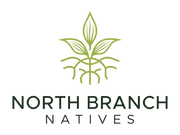First, I would like to say, native gardeners are not (necessarily) restoration folks. We are artists, naturalists and designers working to construct a bridge between the natural world and our understanding of it (thank you for this insight, Professor David Hays). We are interpreters and educators, observers and admirers. So, when asked recently to make the call on “what should I keep” by a client looking to make her landscape a place for birds, there was not a straightforward answer that I could give.
A quick survey of the area showed a weeping Japanese maple given as a gift, a perimeter planting of gnarly honeysuckle shrubs, a small bed of recently added native wildflowers, and a plot of turf that was tended regularly each summer for the past eighteen years. This patch of grass had its own family history of hosting ice skating parties, kids playing and laughing, a dog darting back and forth chasing a small red ball, quiet nighttime getaways around a fire, and the weekly satisfaction of shearing the bright green growth to an acceptable height. What is it about the smell of fresh cut grass anyway?
In my own landscape, I have apple trees —they remind me of the line of trees I climbed as a kid, and a lilac shrub that was given to me by my sister that when it blooms takes me back to the smell of a fresh cut bouquet on my mother’s table. My lawn, with its footprint expanding and contracting like a jelly-fish as our needs changed, was a welcoming getaway during Covid —with a tent that moved around intermittently, leaving bare patches in its wake.
It's ok. This process of naturalizing your landscape and introducing native plant species does not need to be all or none. It can be a phased approach. It can be spotty, experimental, and even at times unsuccessful. But, the important thing in this is: if you are adding something new into your landscape at this point, it really should be native. Not cultivars (cultivated varieties) or nativars (native cultivars). Straight species. Don’t let the big landscape supply stores trick you into thinking that their “butterfly-friendly” annuals or giant double blooming orange Echinacea are the same. They just are not. Check out this page from Xerces society that tells you why, or this recording on habitat gardening.
My advice to you when updating a landscape that has a deep personal history is: Narrow down the important sentimental things to save (those things that your grandmother gave you, for instance) and allow the rest to be re-imagined. Evaluate what is left for function and “feed-ability” and give the remaining landscape back as habitat for seasonal bees and butterflies and migrating birds. Your grandmother would approve, and you will be so much happier for it, I promise.
Need a second opinion? We are happy to come by to share some ideas.

